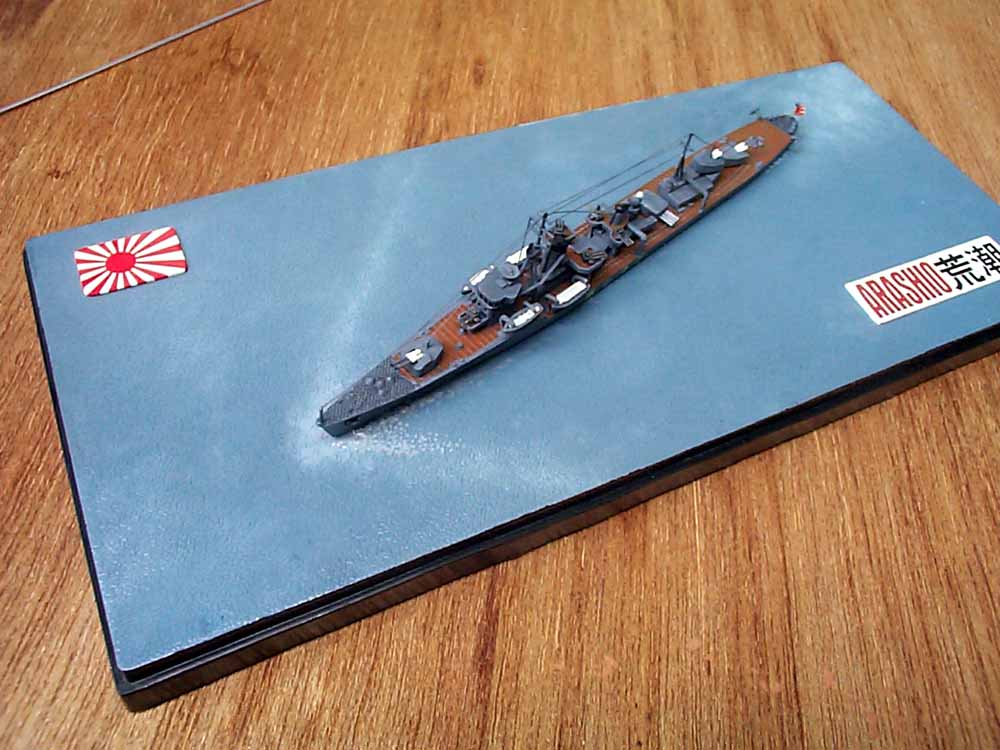by Fernando Torre

1/700 IJN Arashio (Hasegawa)

Like many other modelers I guess I find myself with a big stash of models and due to contraints of everyday life very litle time to build, so I figured that a quicky weekend build was in order for me.
I pulled out a Hasegawa 1/700 model of Arashio with the goal of not dragging on yet another project. I built it straight from the box with only basic rigging made from sprue. I painted it and set it on a base in a 1/25 scale car display jewel box.
The asphalt textured surface lends well to simulate a calm sea and the jewel box protects it well from dust and fingers.
I painted the surface with artists acrylics, the name tags and flags are from the box. All in all, built and painted in about 5 1/2hours on the weekend .
Arashio was part of the Asashio class.
Japan's decision to withdraw from the London Naval Treaty of 1930 and commence unrestricted shipbuilding enabled the Imperial Navy to return to the concept of the large, "cruiser-type" destroyer. After achieving only mixed results in their attempts to cram maximum fighting ability into minimal-displacement destroyers while adhering to the treaty, the Japanese naval establishment would have applauded the ordering of hull numbers 75 to 84 under the 1934 Reinforcement Program. These would become the ten vessels of the Asashio class.
Longer than the preceding Shiratsuyu class by 30 feet and 300 tons heavier, the Asashios were able to return to a main armament of six 5" guns (all mounted in Type C turrets capable of 55-degree elevation) while still retaining eight 24" torpedo tubes, the latters' reloads now situated in an elongated deckhouse on the centerline. New, advanced steam turbines capable of 50,000 shaft horsepower were installed and the top speed of the class was thus raised to 35 knots.
Asashio, the first-completed, experienced serious steering troubles during her trials, with resultant unacceptable maneuverability. She and her sisters were thus fitted with a redesigned stern/rudder arrangement which overcame the problem. Other teething troubles, mainly concerning the new turbines, were also gradually worked out. By the beginning of the Pacific War the Asashios had become models of destroyer design from which the two succeeding classes would vary only slightly.
Though initially inadequately armed against submarines and aircraft, the Asashio class was later fitted with four depth charge throwers to help counter the former (36 depth charges then being carried) and from fourteen to twenty-eight 25 mm. machine guns for use against the latter. To make room for the extra AA, the four units that survived into June 1944 lost their No. 2, or "X", gun turret, and also landed a set of reload torpedoes. These last four were also eventually equipped with Types 13 and 22 radar sets.
During the war Asashio class destroyers operated in the 8th, 9th and 18th Destroyer Divisions, with three of four survivors being consolidated into the 4th Destroyer Division by mid-1944. KASUMI was the longest-lived of the class, but none could match the combat record of splendid Asagumo, one of the busiest destroyers in the fleet. Regarding individual performances, that put on by Desdiv 8's ASASHIO and OSHIO off Bali in February 1942 was the masterpiece. Of the four Asashios sunk in surface combat, three went down in the Surigao Strait death-ride of October 1944. Four others were lost to air attack and two to submarines. None survived the war.
